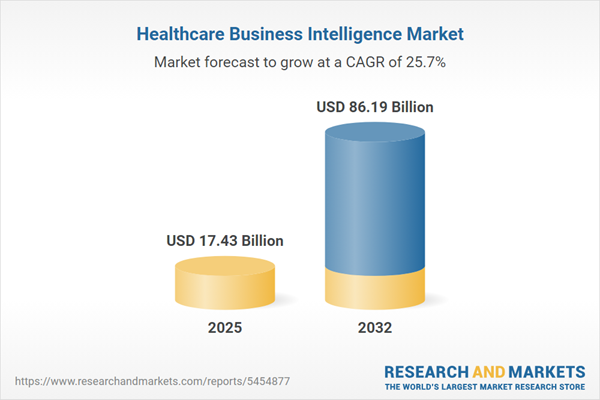Speak directly to the analyst to clarify any post sales queries you may have.
The healthcare business intelligence market is undergoing accelerated transformation as organizations seek to leverage complex data to power patient care, operational performance, and strategic development. Expanding adoption of advanced analytics and digital solutions is enabling healthcare leaders to realize meaningful improvements in outcomes, efficiency, and value delivery.
Market Snapshot: Healthcare Business Intelligence Market
The healthcare business intelligence market grew from USD 13.84 billion in 2024 to USD 17.43 billion in 2025. Continuing its strong momentum, the market is forecast to reach USD 86.19 billion by 2032, driven by a robust CAGR of 25.68%. This growth reflects the sector’s focus on turning clinical, operational, and financial data into actionable insights, as well as the increasing role of digital innovation and artificial intelligence across healthcare enterprises. The primary keyword, healthcare business intelligence market, characterizes ongoing structural change and the growing emphasis on data-driven strategies among healthcare stakeholders.
Scope & Segmentation
This report delivers a comprehensive analysis of the healthcare business intelligence landscape, exploring segment performance, global adoption dynamics, and technology trends.
- Components: Services (including managed and professional services) and software (with hybrid, on premise, and SaaS models).
- Applications: Clinical analytics, financial analytics, operational analytics, and population health management—including descriptive and predictive analytics approaches.
- End Users: Clinics, diagnostic centers, hospitals, and payer organizations.
- Delivery Models: Desktop based, mobile based, web based (with hosted and SaaS delivery options).
- Regions Covered: Americas (North America with United States, Canada, Mexico; Latin America including Brazil, Argentina, Chile, Colombia, Peru), Europe, Middle East & Africa (Europe, Middle East with UAE, Saudi Arabia, Qatar, Turkey, Israel, Africa with South Africa, Nigeria, Egypt, Kenya), Asia-Pacific (China, India, Japan, Australia, South Korea, Indonesia, Thailand, Malaysia, Singapore, Taiwan).
- Key Companies: UnitedHealth Group, Cerner Corporation, IBM, McKesson Corporation, Oracle Corporation, Allscripts Healthcare Solutions, General Electric Company, Koninklijke Philips, Health Catalyst, Microsoft Corporation.
Key Takeaways
- Healthcare organizations are increasingly integrating business intelligence tools to unify data streams for improved decision-making and operational oversight.
- Adoption of self-service analytics and data visualization is enabling faster, more confident responses to clinical and financial challenges without extensive IT support.
- Digital innovation—particularly artificial intelligence and advanced analytics—enhances trend identification, predictive modeling, and pattern analysis for both patient care and administration.
- Mobile and web-based intelligence solutions support care delivery beyond traditional settings, increasing demand for real-time data management and interoperability.
- Industry leaders are forming strategic partnerships and leveraging modular, scalable platforms to address regulatory demands, optimize costs, and drive innovation in healthcare analytics.
- Strong regional variations exist, driven by differing regulatory frameworks, funding models, and digital infrastructure maturity levels across the Americas, EMEA, and Asia-Pacific.
Tariff Impact
The imposition of new U.S. tariffs in 2025 on technology imports is compelling healthcare organizations to reassess their supply chains and vendor strategies. Increased hardware costs and evolving licensing models are encouraging balanced deployment strategies, including hybrid and cloud-based solutions, to manage procurement risks. Diversification of vendor portfolios and adoption of modular architectures are becoming essential to mitigate margin pressures and adapt to shifting trade environments without compromising innovation speed.
Methodology & Data Sources
This analysis utilizes a robust combination of primary interviews with senior stakeholders, analytics leaders, and IT decision makers, combined with validated secondary research from industry publications, regulatory filings, and association reports. Cross-referencing multiple data sources ensures the reliability and accuracy of all key trends and market assessments presented in the report.
Why This Report Matters
- Enables senior decision-makers to benchmark strategies, mitigate supplier risks, and identify growth opportunities in a rapidly evolving marketplace.
- Provides a clear segmentation framework and actionable intelligence to support technology investment, partnership development, and workforce planning initiatives.
Conclusion
The healthcare business intelligence market is poised for sustained expansion as industry leaders prioritize data-driven strategy and operational agility. Those who invest in advanced analytics, governance, and digital transformation will be best equipped to create value and remain resilient amid ongoing change.
Additional Product Information:
- Purchase of this report includes 1 year online access with quarterly updates.
- This report can be updated on request. Please contact our Customer Experience team using the Ask a Question widget on our website.
Table of Contents
3. Executive Summary
4. Market Overview
7. Cumulative Impact of Artificial Intelligence 2025
Companies Mentioned
The companies profiled in this Healthcare Business Intelligence market report include:- UnitedHealth Group Incorporated
- Cerner Corporation
- International Business Machines Corporation
- McKesson Corporation
- Oracle Corporation
- Allscripts Healthcare Solutions, Inc.
- General Electric Company
- Koninklijke Philips N.V.
- Health Catalyst, Inc.
- Microsoft Corporation
Table Information
| Report Attribute | Details |
|---|---|
| No. of Pages | 190 |
| Published | October 2025 |
| Forecast Period | 2025 - 2032 |
| Estimated Market Value ( USD | $ 17.43 Billion |
| Forecasted Market Value ( USD | $ 86.19 Billion |
| Compound Annual Growth Rate | 25.6% |
| Regions Covered | Global |
| No. of Companies Mentioned | 11 |









